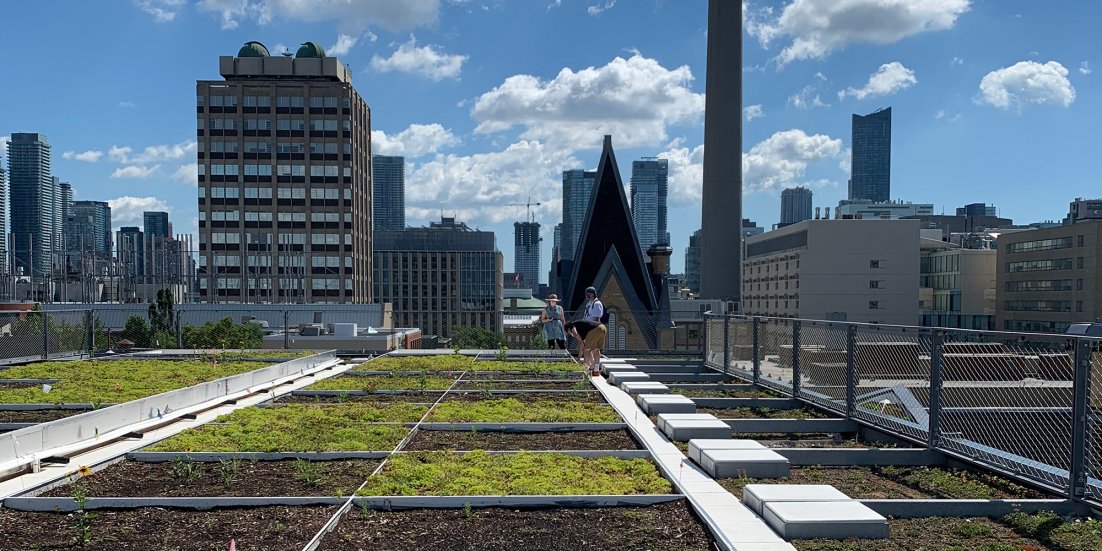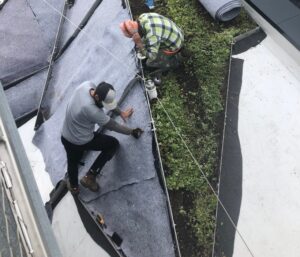
GRIT Lab launches a new NSERC CREATE interdisciplinary training and research program on living green infrastructure
December 2020 will mark a full decade of environmental research at the University of Toronto’s Green Roof Innovation Testing Laboratory (GRIT Lab). Spearheaded by landscape architecture professor Liat Margolis in collaboration with civil engineering professors Jennifer Drake and Brent Sleep, biology professor Scott MacIvor, and forestry professor Sean Thomas, GRIT Lab has become an international hub of interdisciplinary and experimental research on living green infrastructure.
Building upon this legacy, this past summer the GRIT Lab research team launched a new and unique training program named Design of Living Infrastructure for Ecosystem Services (DLIFES) Network. DLIFES is a five-year-long NSERC Create program intended to train over 50 undergraduate, master, PhD, and post-doctoral students in the design, construction, and management of engineered vegetative systems for cities facing the impacts of rapid urbanization and climate change.
“Governments and private property owners across Canada and worldwide are investing heavily in living infrastructure in order to address current and future challenges of environmental degradation, pollution, habitat loss, and extreme climate events,” Margolis says. “This presents a tremendous opportunity to develop 21st-century approaches to education and professional practice that are interdisciplinary by nature, empirical, hands on, and engaged with regional urban policy and industry practices.”
This network, which is the first of its kind, extends throughout Canada, with academic partners at the University of Toronto Scarborough, Ryerson University, Saint Mary’s University, and the University of Saskatchewan. The network also collaborates with eight other universities in the USA, France, Israel, Australia, and Japan that are well known for their green infrastructure experimental labs. The NSERC funding will provide participating students with opportunities for research exchange abroad. Several industry and government partners contribute to the project through technical instruction, advisory board membership, field work opportunities, and in-kind material donations.
Recently constructed sloped green roofs provide new research opportunities.
The DLIFES inaugural summer program was delivered online due to COVID-19. It kicked off with its first annual symposium in June. The symposium brought together project partners to share research findings and insights on project implementation across a broad range of contexts and climates. A virtual networking event allowed students to connect with experts in design, construction, environmental legislation, and conservation fields.
Over a period of four weeks, interdisciplinary coursework delivered by academic, government, and industry partners offered technical training to 22 students in landscape, forestry, engineering, and biology. Students had opportunities to develop command of green roof and low impact development (LID) design and construction, including soil design for bioretention and green roof growth media, and subsurface urban hydrology. Over the next four years, the program’s coursework will cover a range of technical aspects related to landscape design and construction, plant biology and ecology, soil physics and bio-material sourcing and processing, stormwater management, treatment and reuse, sensor instrumentation design, and data visualization.
“This program offers the specialized and practical field-based training that is currently lacking and absolutely critical as technologies and new regulations are rapidly changing,” says Jennifer Drake, a DLIFES principal investigator. “For example, the 2017 federal budget designated upwards of $20 billion in green infrastructure projects over the next decade. New York City’s green infrastructure plan has allocated $1 billion for new projects to reduce combined sewer overflow. And in 2019 they legislated a green roof bylaw like that of Toronto’s as part of their commitment to the Green New Deal.”
DLIFES courses centre focus on living infrastructure and green building technologies.
Second-year Master of Landscape Architecture student Howard Rosenblat studied environmental science and corporate sustainability prior to joining the graduate program at Daniels, lending him a unique perspective on the green industry. “I love peeling back the layers to look at different systems, and I find that design is often disconnected from functionality,” he says. “That is what I loved about these courses. They really make you question the why and how.”
Madison Appleby is also in her second year of the MLA program. “The DLIFES summer program fostered connection and the exchange of information, helping to bridge the gap between disciplines and prevent mistranslation,” she says. “The exposure to innovative research and industry practices, as well as a critical approach to ‘green design,’ is a way of thinking that I will carry forward into my schoolwork and eventual practice.”
In addition to the summer courses and annual symposium, the DLIFES Create Program is leading a number of cutting edge research projects, one of which is the study of cistern-collected surface runoff for reuse in green roof irrigation. This will provide insight into the role of green roofs in mitigating urban pollution and linking site hydrology between the landscapes at the ground and roof levels.
Cistern collected runoff versus potable water irrigation systems are tested on the One Spadina roof.
Another major study being undertaken as part of DLIFES is a survey of the city of Toronto’s green roofs since 2009. Forestry PhD candidate Wenxi Liao and MLA students Howard Rosenblat, Madison Appelby, Allison Smith, and Stefan Herda employed remote sensing techniques to geolocate roughly 700 green roofs, evaluate their endurance or decline over time, and measure the overall effectiveness of green roof practices in Toronto.
The new GRITlab at 1 Spadina was constructed in part thanks to funding from the University of Toronto Lab Innovation for Toronto (LIFT) project. The experimental facility was designed by Baird Sampson Neuert Architects (BSN) with in-kind donations by Industry Partner Bioroof Systems.








